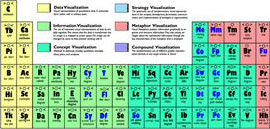The 17th User Experience Newsletter features “A Periodic Table of Visualization Methods”. It’s a wonderful collection and classification of different chart types for very different occasions… (read more)
Category: HCI Design
Human Computer Interaction Design
it is the user's itch that needs to be scratched
Quote:
The first rule of open source development is also the reason for an inherent usability problem: "Every good work of software starts by scratching a developer’s personal itch."The result is a self-referential system – developers develop for themselves rather than for the average user or the target audience. Usability engineering is considered as superfluous extra. However, to provide a good user experience, it is the user’s itch that needs to be scratched.This article presents user experience activities in the context of OpenOffice.org. The author – co-lead of the User Experience Project – will discuss the status of building an open source community of usability professionals to improve the usefulness and usability of the application.(read more…)
FSOSS 2006 /webcasts
webcasts of 2006 symposium on Free Software and Open Source Software. Topics include OpenOffice.org and Sun’s open source strategy.
Technorati Tags: openoffice, Sun, FSOSS
Usability im Unternehmen
Das Kapitel 4 “Usability im Unternehmen” aus “Usability praktisch umsetzen” (Hanser 2003) ist nun online.
Gabriele Fischer im NDR Interview
Gabriele Fischer, Chefredakteurin und Herausgeberin des Wirtschaftmagazins brand eins im Interview auf NDR 4, Der Talk (mp3)
Ivan Sutherland on "Research and Fun"
An Evening with Ivan Sutherland at the Computer History Museum
Requirements Engineering – MuC 2004
Später haben Frieder Strauß, Petra Kowallik und ich die Workshop-Ergebnisse für die i-com zusammengefasst: "Requirements-Engineering im Spannungsfeld von Individual- und Produktsoftware".
Mind the Gap!
Software engineers and interaction architects need to cooperate with each other in order to create software products that work, and that are usable and useful for the target audience. A look at reality shows that the cooperation does not function as smoothly as it should. The cause for this can be on the engineer’s side, or on the designer’s — or on both sides. This paper identifies some differences in the mentalities that make it difficult to work together in one product team.It needs to be said that successful product teams have many more components than just engineering and user interface design. To use Don Norman’s metaphor: it is technology, marketing, and user experience that make up the three legs of a solid product. We also have to add product management, quality management, documentation, customer support, and upper management to the picture. Nevertheless, this paper focuses only on the relation between developers and HCI professionals. [continue]
Summary of design rules by Jef Raskin
In 2002 Jef Raskin wrote to Tom Gilb "A nearly one page summary of design rules".
The first principle. When using a product to help you do a task, the product should only help and never distract you from the task.
The second principle: An interface should be reliable.
The third princple: An interface should be efficient and as simple as possible.
The fourth principle: The suitability of an interface can only be determined by testing.
The fifth principle: An interface should be pleasant in tone and visually attractive.
Then Jef Raskin concludes:
An interface should be effective, habituating, reliable, efficient, and tested. To the extend that doing so does not conflict with these essentials, an interface should also be attractive.
[read Jef’s nearly one page summary of Raskin’s design rules]
The Maryland Way
Ben Shneiderman explains what makes the HCIL so successful. It is 7 (simple) ideas that foster innovation and team spirit:
- Choose a good driving problem
- Become immersed in related work
- Clarify short-term and long-term goals
- Balance individual and group interests
- Work hard
- Communicate with internal and external stakeholders
- Get past failures. Celebrate success!
Read the complete Maryland Way.
